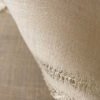Bemberg - The Fabric Made Out of Waste
Before becoming a fabric ready to be stitched, the cotton goes through several processes like ginning, spinning, dyeing etc. Ginning is the process of separating cotton from its seeds. Post the ginning process, the fuzzy material left on the cottonseeds is called linter. This linter is, usually, thrown away.
Asahi Kasei has come with a brilliant technology that produces yarn from the same linter! Thus, reducing waste exponentially.
Now that we know what is Bemberg, let’s address the bigger question – How sustainable is it?
Made from a natural byproduct of cotton, Bemberg is biodegradable and compostable. Here are some astonishing facts about Bemberg and its impact on the environment.

Bemberg breaks down naturally in soil. In ideal conditions (35°C temperature and 80% humidity), it takes Bemberg just two months to degrade one half in weight.

On combustion, the fibre produces 52% less CO2 ppm than Nylon, 19% less than Polyester, 4% less both Silk and Wool.

No additional cultivation of raw materials is required for the production of Bemberg as the pre-consumer cotton waste serves as the raw material for Bemberg.

40% of the energy consumed in producing Bemberg is renewable.

The process of generating Bemberg contributes ZERO WASTE to the landfills, implying that any fabric waste obtained is reused and recycled as fuel for power generation.
Let’s have a comparative view at the emissions produced on burning Bemberg and other fibres.




